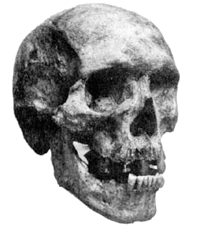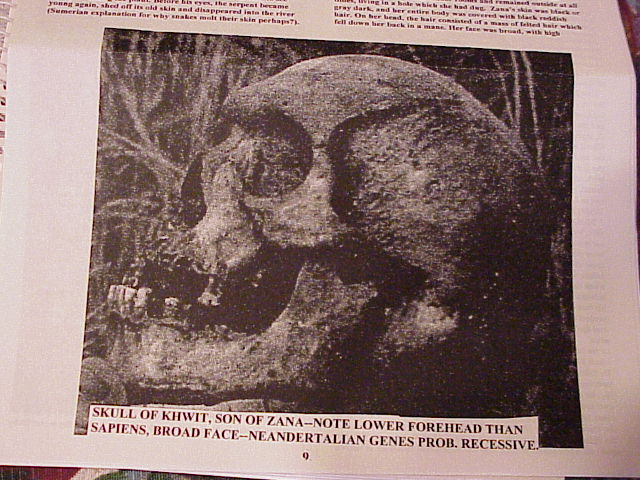A Skeleton Still Buried and a Skull
Unearthed: The Story of Zana
By Igor Bourtsev
From: "In the Footsteps of the Russian Snowman" by Dmitri Bayanov
Zana was a female abnauayu who had been caught and tamed and who lived and died within the memory of a number of people still alive at the time of the research. She was buried near the village of Tkhina in the Ochamchiri District of Abkhazia in the 1880s or 1890s.
The manner of her capture is vague. Some said it was not a chance catch. Hunters familiar with an age-old technique tied her up, and, when she furiously fought back, hit her with cudgels, gagged her mouth with felt, and shackled her legs to a log. Probably she had already changed hands by sale when she became property of the ruling prince D.M.Achba who was the titular head of the Zaadan region. She passed into the possession of one of his vassals, named Chelokua and still later she was presented to a nobleman, Edgi Genaba, who visited the region. He took her away, still shackled and chained, to his estate in the village of Tkhina on the Mokva River, 78 kilometres from Sukhumi.
At first Genaba lodged her in a very strong enclosure and nobody ventured in to give her food, for she acted like a wild beast. It was thrown to her. She dug herself a hole in the ground and slept in it and for the first three years she lived in this wild state, gradually becoming tamer. After three years she was moved to a wattle-fence enclosure under an awning near the house, tethered at first, but later she was let loose to wander about. However she never went far from the place where she received her food. She could not endure warm rooms and the year round, in any weather, slept outdoors in a hole that she made herself under the awning.
Villagers teased her with sticks thrust through the wattle-fence, and she.would snatch them with fury, bare her teeth and howl.
Her skin was black, or dark grey, and her whole body covered with reddish-black hair. The hair on her head was tousled and thick, hanging mane-like down her back.
She could not speak, over decades that she lived with people, Zana did not learn a single Abkhaz word; she only made inarticulate sounds and mutterings, and cries when irritated. But she reacted to her name, carried out commands given by her master and was scared when he shouted at her. And this despite the fact that she was very tall, massive and broad, with huge breasts and buttocks, muscular arms and legs, and fingers that were longer and thicker than human fingers. She could splay her toes widely and move apart the big toe.
From remembered descriptions given to Mashkovtsev and Porshnev, her face was terrifying; broad, with high cheekbones, flat nose, turned out nostrils, muzzle-like jaws, wide mouth with large teeth, low forehead, and eyes of a reddish tinge. But the most frightening feature was her expression which was purely animal, not human. Sometimes, she would give a spontaneous laugh, baring those big white teeth of hers. The latter were so strong that she easily cracked the hardest walnuts.
She lived for many years without showing any change: no grey hair, no falling teeth, keeping strong and fit as ever. Her athletic power was enormous. She would outrun a horse, and swim across the wild Mokva River even when it rose in violent high tide. Seemingly without effort she lifted with one hand an eighty-kilo sack of flour and carried it uphill from the water-mill to the village. She climbed trees to get fruit, and to gorge herself with grapes she would pull down a whole vine growing around the tree. She ate whatever was offered to her, including hominy and meat, with bare hands and enormous gluttony. She loved wine, and was allowed her fill, after which she would sleep for hours in a swoonlike state.
She liked to lie in a cool pool side by side with buffalos. At night she used to roam the surrounding hills. She wielded big sticks against dogs and on other perilous occasions. She had a curious obsession for playing with stones, knocking one against another and splitting them.
She took swims the year round, and preferred to walk naked even in winter, tearing dresses that she was given into shreds. However, she showed more tolerance toward a loin-cloth. Sometimes she went into the house, but the women were afraid of her and came near only when she was in a gentle mood; when angry she, presented a scary sight and could even bite. But she obeyed her master, Edgi Genaba, and he knew how to bring her to heel. Adults used her as a bogy figure with children, although Zana never actually attacked children.
She was trained to perform simple domestic tasks, such as grinding grain for flour, bringing home firewood and water, or sacks to and from the water-mill, or pull her master's high boots off.
But she became the mother of human children, and this is the wonderous side of her life story, very important for the science of genetics. Zana was pregnant several times by various men, and, giving birth without assistance, she always washed the newborn child in the cold water-spring. The half-breed infants, unable to survive these ablutions, died.
So, when subsequently Zana gave birth, the villagers began taking the newborn babies away from her in good time, and reared them themselves. Four times this happened, and the children, two sons and two daughters, grew up as humans, fully-fledged and normal men and women who could talk and possessed reason. It is true that they had some strange physical and mental features, but nonetheless they were fully capable of engaging in work and social Life
The eldest son's name was Dzhanda, and the eldest daughier was Kodzhanar. The second daughter was named Gamasa, and the younger son Khwit, who died in 1954. All had descendants of their own, scattered across Abkhazia.
There were rumours that the father of Gamasa and Khwit was in fact Edgi Genaba himself, but in the census they were put down under a different surname, and their family-name became Sabekia. It is significant that Zana was buried in the family cemetery of the Genabas, and that the two youngest children of Zana were brought up by Genaba's wife.
Gamasa and Khwit were both powerfully built, had dark skins, but they inherited scarcely anything from Zana's facial appearance. The complex of human features, inherited from their father, was dominant in them and overruled the mother's line of descent. Khwit, who died at the age of 65 or 70, was described by his fellow-villagers as little different from the human norm, except for certain small divergences. He was extremely strong, difficult to deal with and quick to pick a fight. In fact, he lost his right hand after one of the many fights he had with his fellow-villagers, but his left hand sufficed him to mow and do other work on a collective farm, and even climb trees. When old, he moved to the town of Tkvarcheli where he eventually died, but he was taken back for burial at Tkhina.
The next stage of the Zana case was taken up by attempts fo find her grave and skeleton. Here is what Boris Porshnev Says about his first effort in that direction:
In September 1964, the archaeologist V.S.Orelkin and I made our first attempt to find Zana's grave. The cemetery was wildly overgrown and only the ten-year-old mound over Khwit's grave could be picked out among the bracken covering the hillside. Nobody else had been buried since then.
Zana must be somewhere near. We asked the old residents and the last scion of the Genaba dan, seventy-nine-year-old Kenton. He was clear that we should dig under a pomegranate tree. What was found there turned out to be the remains of one of Zana's grandchildren who had died early, for the profile that we established from the skull was extraordinarily like the profiles of Zana's two living grandchildren whom I myself had met.
After two more expeditions the search party had still not found Zana's bones, though in a third attempt in October 1965, they found what are probably the bones of Gamasa, as they present slight, but definite paleoanthropic features.
After the passing of Porshnev it fell to my lot to continue the search. I headed three expeditions to Abkhazia in search of Zana's skeleton, in 1971, 1975 and 1978, which merits a separate story. Our difficulty was that by that time the last scion of the Genaba dan had passed away and nobody knew exactly where Zana's grave was. We put in a tremendous amount of spade work on that hillside, digging sticky clayey earth under almost daily downpours. During the second expedition I was taken seriously ill with an illness which doctors failed to identify. We never found a skeleton that would fit Zana's features as described by witnesses.
It was then decided to exhume the skull of Khwit, Zana's younger son, whose grave was still well indicated. Professor N. Bourchak-Abramovich assisted me in that digging. I brought the skull to Moscow where it was studied by two physical anthropologists, M.A.Kolodieva and M.M.Gerasimova. The results of the study were reported by me at the Relict Hominoid Research Seminar and the Moscow Naturalists' Society and published in 1987.
 |
| The exhumed skull of Zana's son, Khwit, exhibits a combination of modern and ancient features which aroused great interest amongst anthropologists |
(See Additional Photo of Zana's son at the bottom of this article)
Anthropologist M.A.Kolodieva compared the skull of Khwit with the male skulls from Abkhazia in the collection of the Moscow State University Institute of Anthropology and found that Khwit's skull was significantly different. Indicating it as the Tkhina skull, she writes:
The Tkhina skull exhibits an original combination of modem and ancient features ... The facial section of the skull is significantly larger in comparison with the mean Abkhaz type ... All the measurements and indices of the superciliary cranial contour are greater not only than those of the mean Abkhaz series, but also than those of maximum size of some fossil skulls studied (or rather were comparable with the latter). The Tkhina skull approaches closest the Neolithic Vovnigi II skulls of the fossil series...On her part, anthropologist M.M.Gerasimova came to following conclusions:
The skull discloses a great deal of peculiarity, a certain disharmony disequilibrium in its features, very large dimensions of the facial skeleton, increased development of the contour of the skull, specificity of the non-metric features (the two foramina mentale in the lower jaw, the intrusive bones in the sagittal suture, and the Inca bone). The skull merits further extended study.So the bottom line of the Zana case today is this: we have nothing but the words of witnesses to describe Zana's peculiar nature, but the hard and specific evidence of her son's skull goes a long way in making the testimony of witnesses more solid and trustworthy.
Text From: In the Footsteps of the Russian Snowman by Dmitri
Bayanov.
(1996, Moscow, Russia: Crypto-Logos, pp. 46-52)
Additional Photo of Zana's son, reference unknown:

Back
to Newspaper & Magazine Articles
Main
Back to Stories, Letter etc..